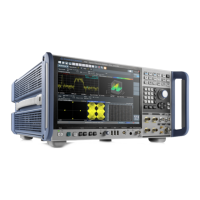Common Measurement Settings
R&S
®
FSW
414User Manual 1173.9411.02 ─ 43
Example:
For example, for the level measured at the frequency 50 GHz, 43 correction levels are
defined:
●
21 for the frequencies 48.075 GHz, 49.125 GHz, 49.175 GHz, ..., 49.975 GHz
●
1 for the frequency 50 GHz
●
21 for the frequencies 50.025 GHz, 50.075 GHz, 50.125 GHz, ..., 51.025 GHz
B2000-specific conversion loss tables are provided in files according to the following
syntax:
<serial_no.>_MAG_<harmonic>_B2000.b2g
Phase correction tables
In addition to the magnitude correction tables, B2000 phase correction tables with the
same layout are defined in a separate file. Both files are always delivered as a pair by
the manufacturer of the external mixer. Currently, the R&S FSW uses only the magni-
tude correction files for external mixers; the phase is assumed to be ideal (correction
values are all 0).
B2000-specific phase conversion loss tables are provided in files according to the fol-
lowing syntax:
<serial_no.>_PHASE_<harmonic>_B2000.b2g
B5000-specific conversion loss tables
For bandwidths larger than 2 GHz, two different types of conversion loss tables are
available, depending on the required bandwidth:
●
For bandwidths ≤4.4 GHz: table consists of 91 correction values per frequency, for
an IF of 2.8 GHz
The tables are provided in files according to the following syntax:
<serial_no.>_MAG|PHASE_<harmonic>_B5000_2G8.b5g
●
For bandwidths between 4.4 GHz and 5 GHz: table consists of 103 correction val-
ues per frequency, for an IF of 3.5 GHz
The tables are provided in files according to the following syntax:
<serial_no.>_MAG|PHASE_<harmonic>_B5000_3G5.b5g
Currently, the R&S FSW uses only the magnitude correction files; the phase is
assumed to be ideal (correction values are all 0).
Automatic Signal Identification
Automatic signal identification allows you to compare the upper and lower band results
of the mixer, thus detecting unwanted mixer products due to conversion.
Note that automatic signal identification is only available for measurements that per-
form frequency sweeps (not in vector signal analysis or the I/Q Analyzer, for instance).
The "Auto ID" function is now also available for Spectrum Emission Mask (SEM) Mea-
surement and Spurious Emissions Measurement using an external mixer.
Data Input and Output

